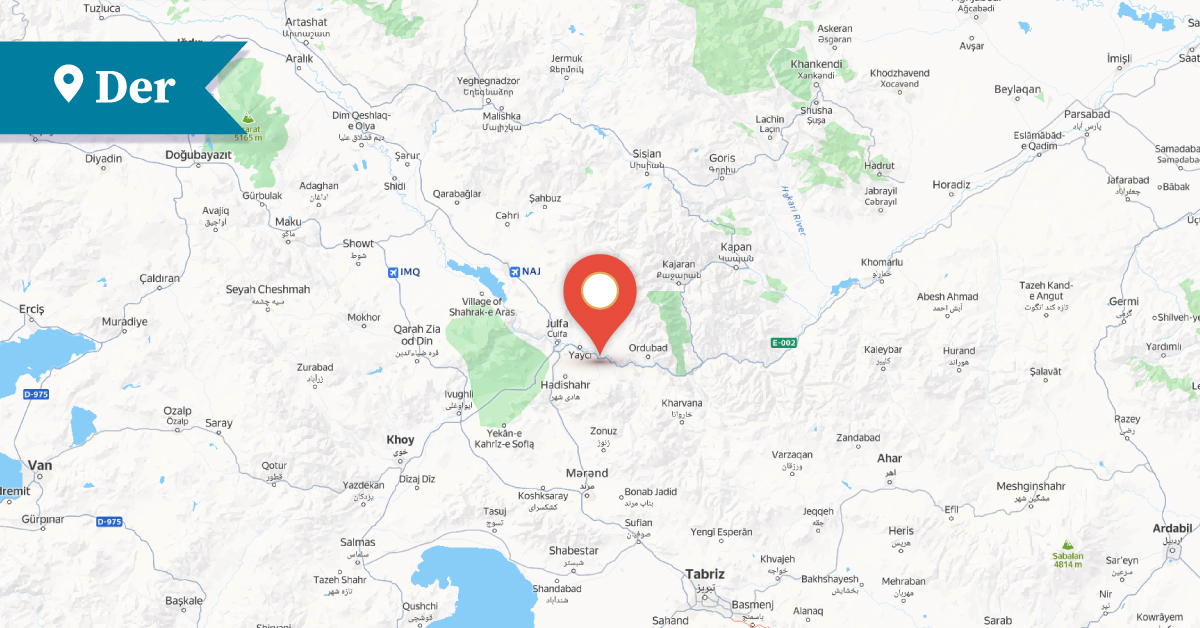2026
2026
2025-08-28

Der was one of the Armenian villages of the historical Goghtn (Goghtan) district of Vaspurakan. It is located on the right bank of the Gilan River, about 1 km away from the Araks, in the lowland area between the villages of Upper and Lower Aza.[1] It is 19 kilometers northwest of the town of Ordubad. The village was also called Tern and belonged to the ecclesiastical diocese of Goghtn.[2] It had been entirely inhabited by Armenians. During the Arab invasions and domination, Arabs settled there. As evidence, remains of a mosque and minaret dating to the 13th–14th centuries have been preserved. However, starting from the 14th century, the village once again became inhabited by Armenians.[3]
In 1829, settlers from the village of Sulduz in the Maragha district of historical Atropatene settled in Der.[4]
The population of Der was mainly engaged in gardening, vegetable growing, and animal husbandry.
The church of the Holy Mother of God, built in the 17th century, stood in the center of the village. It was a three-nave basilica with its entrance on the western façade. Inscriptions were present on the eastern facade. The church had no murals, reliefs, or decorative carvings. According to records, it was renovated in the 17th century, and in 1895 it was again restored through the efforts of Der’s residents. Satellite images taken in 1973 show the church still intact. In photographs from 2004, however, the southern wall appears demolished. Satellite imagery from 2010 confirms that the Azerbaijanis had destroyed the church and built a smaller building in its place, which now serves as a shop.[5]
In the 14th–15th centuries, the Chapel of St. Sargis was built about 1–1.5 kilometers northwest of the village, on a small hill. The chapel has no vestries, inscriptions, or decorative carvings. Several khachkars dating to the 14th–17th centuries have been preserved in its vicinity. The chapel was first mentioned in 1863 and was renovated in 1943. At present, the roof and upper parts of the walls are in ruins.
In 1873, the Der had 60 households with 450 Armenian inhabitants; at the beginning of the 20th century—71 households with 478 Armenians; and by the mid-1980s—60 households.[6] During the Soviet period, the village had a school, a club, and a library, and it was incorporated into the collective farm of the village of Aza.
The last Armenian residents of Der were forced to leave the village in November 1988.[7]
Today, the village lies within the Ordubad district of the Nakhijevan Autonomous Republic, is populated by Azerbaijanis, and is called Darkend.[8]
Bibliography
Ghevond Alishan, Sisakan, Venice, 1893.
Yervand Lalayan, Nakhijevan Province, Book XI, 1904.
Nakhijevan Atlas, Research on Armenian Architecture Foundation, Yerevan, 2012.
A. Ayvazyan, The Armenian Monuments of the Nakhijevan ASSR: A Comprehensive List, Yerevan, 1986.
T. Kh. Hakobyan, St. T. Melik-Bakhshyan, H. Kh. Barseghyan, Dictionary of Toponyms of Armenia and Adjacent Regions, Vol. 2, Yerevan, 1988.
Armenian Soviet Encyclopedia, volume 3, Yerevan, 1977.
Vardanyan, A. Aznaberd, the Last Fortress of Nakhijevan: A Historical-Philological Study. Yerevan, 2000.
Caucasus Heritage Watch (CHW), Special Report #1, Cornel University, USA, 2022, https://arcg.is/18v5Cv3
[1] Yervand Lalayan, Nakhijevan Province, Book XI, 1904, p. 333.
[2] Ghevond Alishan, Sisakan, Venice, 1893, p. 346.
[3] Armenian Soviet Encyclopedia, volume 3, Yerevan, 1977, p. 359.
[4] T. Kh. Hakobyan, St. T. Melik-Bakhshyan, H. Kh. Barseghyan, Dictionary of Toponyms of Armenia and Adjacent Regions, Vol. 2, Yerevan, 1988, p. 85.
[5] Nakhijevan Atlas, Research on Armenian Architecture Foundation, Yerevan, 2012, p. 24.
[6] T. Kh. Hakobyan, St. T. Melik-Bakhshyan, H. Kh. Barseghyan, Dictionary of Toponyms of Armenia and Adjacent Regions, Vol. 2, Yerevan, 1988, p. 85.
[7] Vardanyan, A. Aznaberd, the Last Fortress of Nakhijevan: A Historical-Philological Study. Yerevan, 2000, p. 6.
[8] Der now is called Darkend, in Azerbaijani - Darkənd.